AusNet Services Ltd: Financial Analysis, Budgeting and Investments
VerifiedAdded on 2023/06/12
|12
|2747
|280
Report
AI Summary
This report provides a comprehensive analysis of accounting for decision-making, focusing on AusNet Services Ltd. It covers three main tasks: identifying sources of financial information and areas needing further analysis, preparing a business budget considering various factors, and analyzing a potential capital investment. The report examines financial statements, interim reports, and budgets as key data sources, emphasizing the importance of analyzing financial constraints, organizational targets, legal requirements, and accounting conventions in budgeting. Furthermore, it evaluates proposed capital investments, such as building a distribution line and a new power generation site, using NPV analysis and payback period methods to assess their viability and strategic impact on AusNet Services Ltd.

Running head: ACCOUNTING FOR DECISION MAKING
Accounting for Decision Making
Name of the Student:
Name of the University:
Author’s Note:
Accounting for Decision Making
Name of the Student:
Name of the University:
Author’s Note:
Paraphrase This Document
Need a fresh take? Get an instant paraphrase of this document with our AI Paraphraser
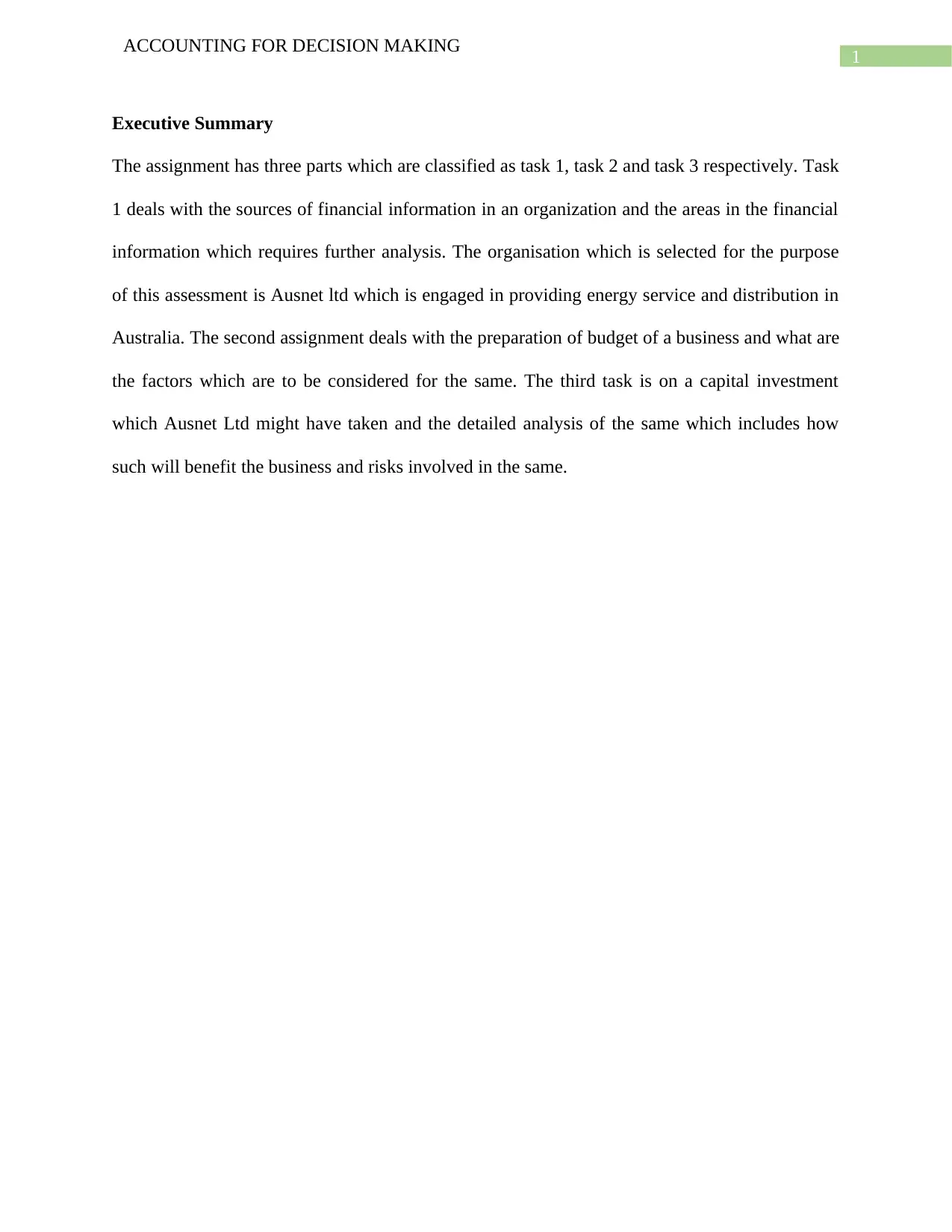
1
ACCOUNTING FOR DECISION MAKING
Executive Summary
The assignment has three parts which are classified as task 1, task 2 and task 3 respectively. Task
1 deals with the sources of financial information in an organization and the areas in the financial
information which requires further analysis. The organisation which is selected for the purpose
of this assessment is Ausnet ltd which is engaged in providing energy service and distribution in
Australia. The second assignment deals with the preparation of budget of a business and what are
the factors which are to be considered for the same. The third task is on a capital investment
which Ausnet Ltd might have taken and the detailed analysis of the same which includes how
such will benefit the business and risks involved in the same.
ACCOUNTING FOR DECISION MAKING
Executive Summary
The assignment has three parts which are classified as task 1, task 2 and task 3 respectively. Task
1 deals with the sources of financial information in an organization and the areas in the financial
information which requires further analysis. The organisation which is selected for the purpose
of this assessment is Ausnet ltd which is engaged in providing energy service and distribution in
Australia. The second assignment deals with the preparation of budget of a business and what are
the factors which are to be considered for the same. The third task is on a capital investment
which Ausnet Ltd might have taken and the detailed analysis of the same which includes how
such will benefit the business and risks involved in the same.
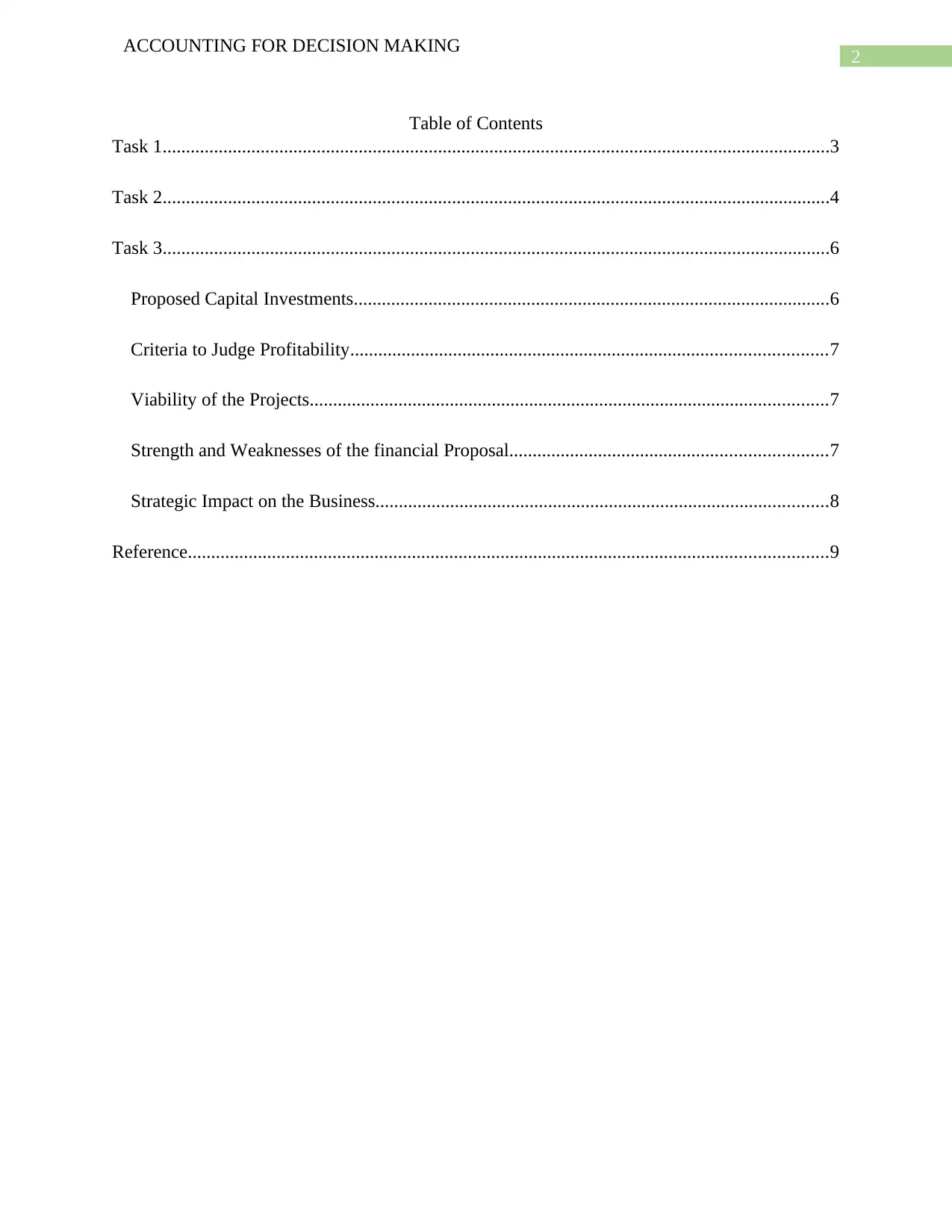
2
ACCOUNTING FOR DECISION MAKING
Table of Contents
Task 1...............................................................................................................................................3
Task 2...............................................................................................................................................4
Task 3...............................................................................................................................................6
Proposed Capital Investments......................................................................................................6
Criteria to Judge Profitability......................................................................................................7
Viability of the Projects...............................................................................................................7
Strength and Weaknesses of the financial Proposal....................................................................7
Strategic Impact on the Business.................................................................................................8
Reference.........................................................................................................................................9
ACCOUNTING FOR DECISION MAKING
Table of Contents
Task 1...............................................................................................................................................3
Task 2...............................................................................................................................................4
Task 3...............................................................................................................................................6
Proposed Capital Investments......................................................................................................6
Criteria to Judge Profitability......................................................................................................7
Viability of the Projects...............................................................................................................7
Strength and Weaknesses of the financial Proposal....................................................................7
Strategic Impact on the Business.................................................................................................8
Reference.........................................................................................................................................9
⊘ This is a preview!⊘
Do you want full access?
Subscribe today to unlock all pages.

Trusted by 1+ million students worldwide
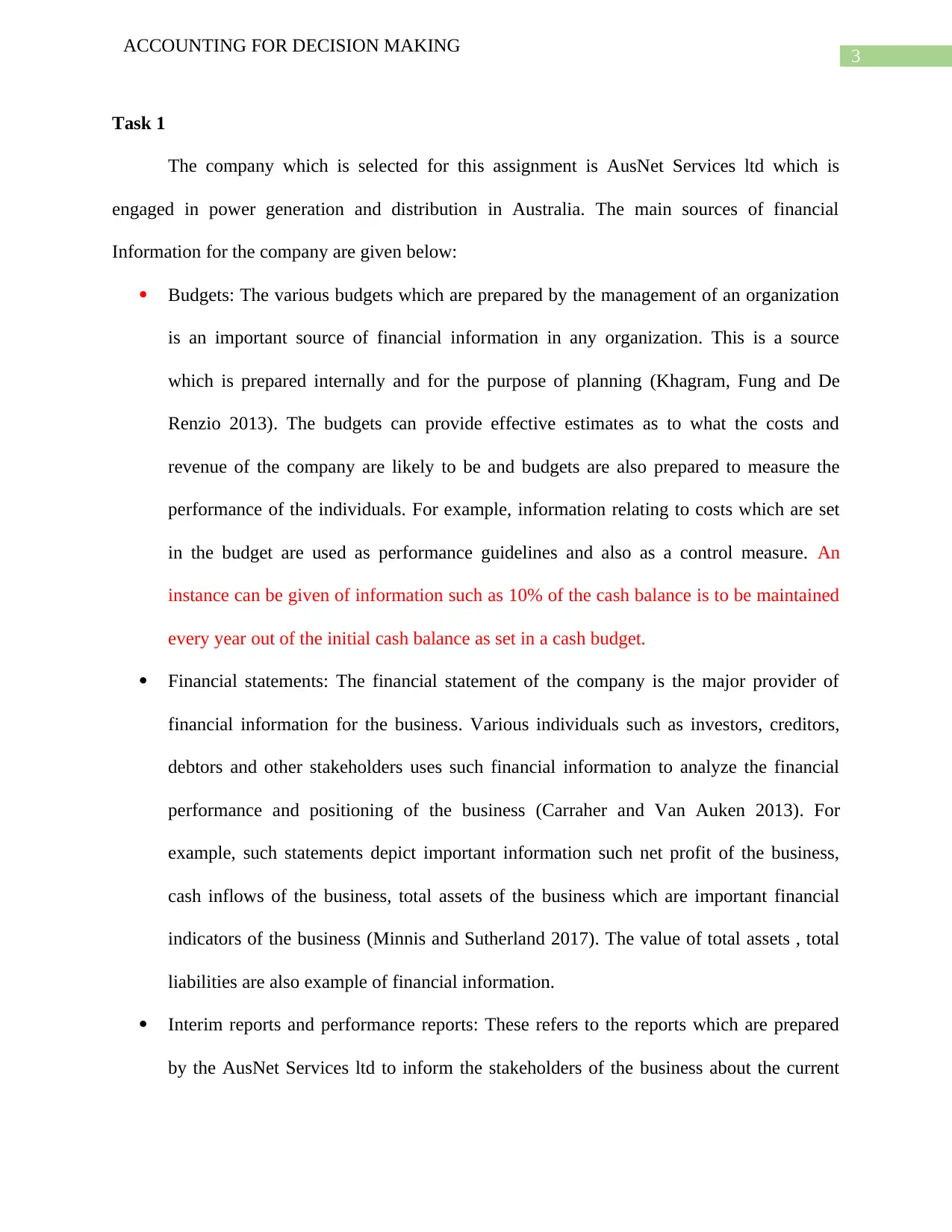
3
ACCOUNTING FOR DECISION MAKING
Task 1
The company which is selected for this assignment is AusNet Services ltd which is
engaged in power generation and distribution in Australia. The main sources of financial
Information for the company are given below:
Budgets: The various budgets which are prepared by the management of an organization
is an important source of financial information in any organization. This is a source
which is prepared internally and for the purpose of planning (Khagram, Fung and De
Renzio 2013). The budgets can provide effective estimates as to what the costs and
revenue of the company are likely to be and budgets are also prepared to measure the
performance of the individuals. For example, information relating to costs which are set
in the budget are used as performance guidelines and also as a control measure. An
instance can be given of information such as 10% of the cash balance is to be maintained
every year out of the initial cash balance as set in a cash budget.
Financial statements: The financial statement of the company is the major provider of
financial information for the business. Various individuals such as investors, creditors,
debtors and other stakeholders uses such financial information to analyze the financial
performance and positioning of the business (Carraher and Van Auken 2013). For
example, such statements depict important information such net profit of the business,
cash inflows of the business, total assets of the business which are important financial
indicators of the business (Minnis and Sutherland 2017). The value of total assets , total
liabilities are also example of financial information.
Interim reports and performance reports: These refers to the reports which are prepared
by the AusNet Services ltd to inform the stakeholders of the business about the current
ACCOUNTING FOR DECISION MAKING
Task 1
The company which is selected for this assignment is AusNet Services ltd which is
engaged in power generation and distribution in Australia. The main sources of financial
Information for the company are given below:
Budgets: The various budgets which are prepared by the management of an organization
is an important source of financial information in any organization. This is a source
which is prepared internally and for the purpose of planning (Khagram, Fung and De
Renzio 2013). The budgets can provide effective estimates as to what the costs and
revenue of the company are likely to be and budgets are also prepared to measure the
performance of the individuals. For example, information relating to costs which are set
in the budget are used as performance guidelines and also as a control measure. An
instance can be given of information such as 10% of the cash balance is to be maintained
every year out of the initial cash balance as set in a cash budget.
Financial statements: The financial statement of the company is the major provider of
financial information for the business. Various individuals such as investors, creditors,
debtors and other stakeholders uses such financial information to analyze the financial
performance and positioning of the business (Carraher and Van Auken 2013). For
example, such statements depict important information such net profit of the business,
cash inflows of the business, total assets of the business which are important financial
indicators of the business (Minnis and Sutherland 2017). The value of total assets , total
liabilities are also example of financial information.
Interim reports and performance reports: These refers to the reports which are prepared
by the AusNet Services ltd to inform the stakeholders of the business about the current
Paraphrase This Document
Need a fresh take? Get an instant paraphrase of this document with our AI Paraphraser
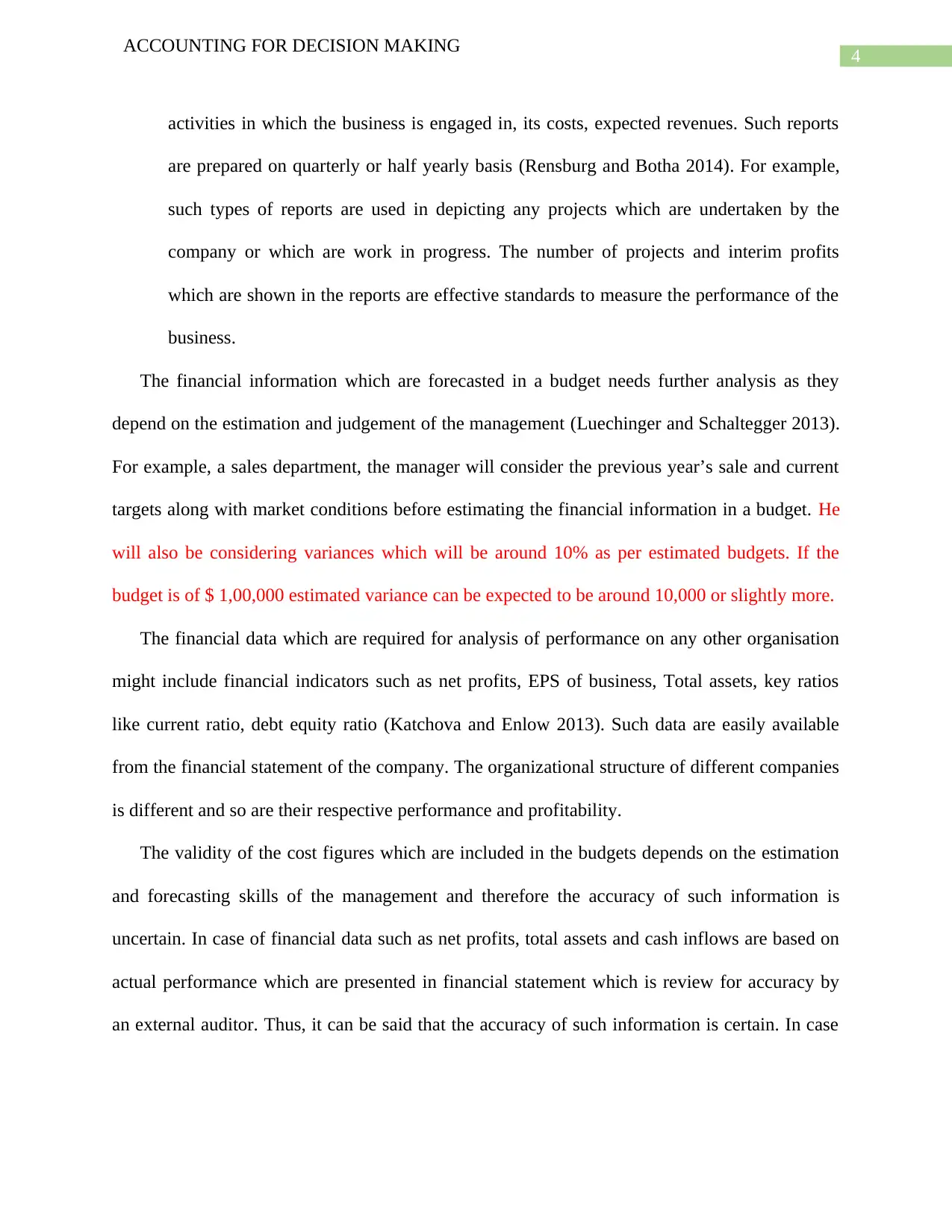
4
ACCOUNTING FOR DECISION MAKING
activities in which the business is engaged in, its costs, expected revenues. Such reports
are prepared on quarterly or half yearly basis (Rensburg and Botha 2014). For example,
such types of reports are used in depicting any projects which are undertaken by the
company or which are work in progress. The number of projects and interim profits
which are shown in the reports are effective standards to measure the performance of the
business.
The financial information which are forecasted in a budget needs further analysis as they
depend on the estimation and judgement of the management (Luechinger and Schaltegger 2013).
For example, a sales department, the manager will consider the previous year’s sale and current
targets along with market conditions before estimating the financial information in a budget. He
will also be considering variances which will be around 10% as per estimated budgets. If the
budget is of $ 1,00,000 estimated variance can be expected to be around 10,000 or slightly more.
The financial data which are required for analysis of performance on any other organisation
might include financial indicators such as net profits, EPS of business, Total assets, key ratios
like current ratio, debt equity ratio (Katchova and Enlow 2013). Such data are easily available
from the financial statement of the company. The organizational structure of different companies
is different and so are their respective performance and profitability.
The validity of the cost figures which are included in the budgets depends on the estimation
and forecasting skills of the management and therefore the accuracy of such information is
uncertain. In case of financial data such as net profits, total assets and cash inflows are based on
actual performance which are presented in financial statement which is review for accuracy by
an external auditor. Thus, it can be said that the accuracy of such information is certain. In case
ACCOUNTING FOR DECISION MAKING
activities in which the business is engaged in, its costs, expected revenues. Such reports
are prepared on quarterly or half yearly basis (Rensburg and Botha 2014). For example,
such types of reports are used in depicting any projects which are undertaken by the
company or which are work in progress. The number of projects and interim profits
which are shown in the reports are effective standards to measure the performance of the
business.
The financial information which are forecasted in a budget needs further analysis as they
depend on the estimation and judgement of the management (Luechinger and Schaltegger 2013).
For example, a sales department, the manager will consider the previous year’s sale and current
targets along with market conditions before estimating the financial information in a budget. He
will also be considering variances which will be around 10% as per estimated budgets. If the
budget is of $ 1,00,000 estimated variance can be expected to be around 10,000 or slightly more.
The financial data which are required for analysis of performance on any other organisation
might include financial indicators such as net profits, EPS of business, Total assets, key ratios
like current ratio, debt equity ratio (Katchova and Enlow 2013). Such data are easily available
from the financial statement of the company. The organizational structure of different companies
is different and so are their respective performance and profitability.
The validity of the cost figures which are included in the budgets depends on the estimation
and forecasting skills of the management and therefore the accuracy of such information is
uncertain. In case of financial data such as net profits, total assets and cash inflows are based on
actual performance which are presented in financial statement which is review for accuracy by
an external auditor. Thus, it can be said that the accuracy of such information is certain. In case
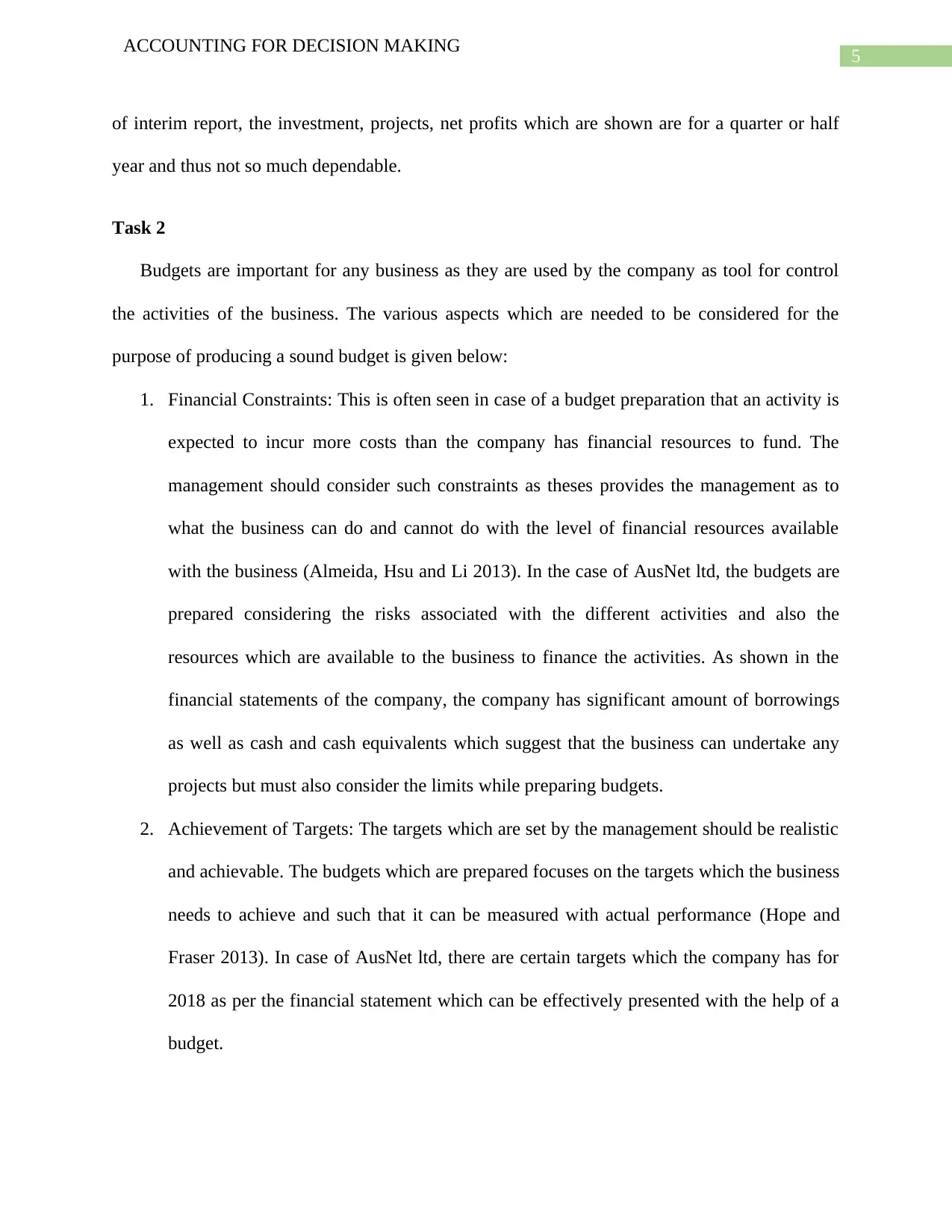
5
ACCOUNTING FOR DECISION MAKING
of interim report, the investment, projects, net profits which are shown are for a quarter or half
year and thus not so much dependable.
Task 2
Budgets are important for any business as they are used by the company as tool for control
the activities of the business. The various aspects which are needed to be considered for the
purpose of producing a sound budget is given below:
1. Financial Constraints: This is often seen in case of a budget preparation that an activity is
expected to incur more costs than the company has financial resources to fund. The
management should consider such constraints as theses provides the management as to
what the business can do and cannot do with the level of financial resources available
with the business (Almeida, Hsu and Li 2013). In the case of AusNet ltd, the budgets are
prepared considering the risks associated with the different activities and also the
resources which are available to the business to finance the activities. As shown in the
financial statements of the company, the company has significant amount of borrowings
as well as cash and cash equivalents which suggest that the business can undertake any
projects but must also consider the limits while preparing budgets.
2. Achievement of Targets: The targets which are set by the management should be realistic
and achievable. The budgets which are prepared focuses on the targets which the business
needs to achieve and such that it can be measured with actual performance (Hope and
Fraser 2013). In case of AusNet ltd, there are certain targets which the company has for
2018 as per the financial statement which can be effectively presented with the help of a
budget.
ACCOUNTING FOR DECISION MAKING
of interim report, the investment, projects, net profits which are shown are for a quarter or half
year and thus not so much dependable.
Task 2
Budgets are important for any business as they are used by the company as tool for control
the activities of the business. The various aspects which are needed to be considered for the
purpose of producing a sound budget is given below:
1. Financial Constraints: This is often seen in case of a budget preparation that an activity is
expected to incur more costs than the company has financial resources to fund. The
management should consider such constraints as theses provides the management as to
what the business can do and cannot do with the level of financial resources available
with the business (Almeida, Hsu and Li 2013). In the case of AusNet ltd, the budgets are
prepared considering the risks associated with the different activities and also the
resources which are available to the business to finance the activities. As shown in the
financial statements of the company, the company has significant amount of borrowings
as well as cash and cash equivalents which suggest that the business can undertake any
projects but must also consider the limits while preparing budgets.
2. Achievement of Targets: The targets which are set by the management should be realistic
and achievable. The budgets which are prepared focuses on the targets which the business
needs to achieve and such that it can be measured with actual performance (Hope and
Fraser 2013). In case of AusNet ltd, there are certain targets which the company has for
2018 as per the financial statement which can be effectively presented with the help of a
budget.
⊘ This is a preview!⊘
Do you want full access?
Subscribe today to unlock all pages.

Trusted by 1+ million students worldwide
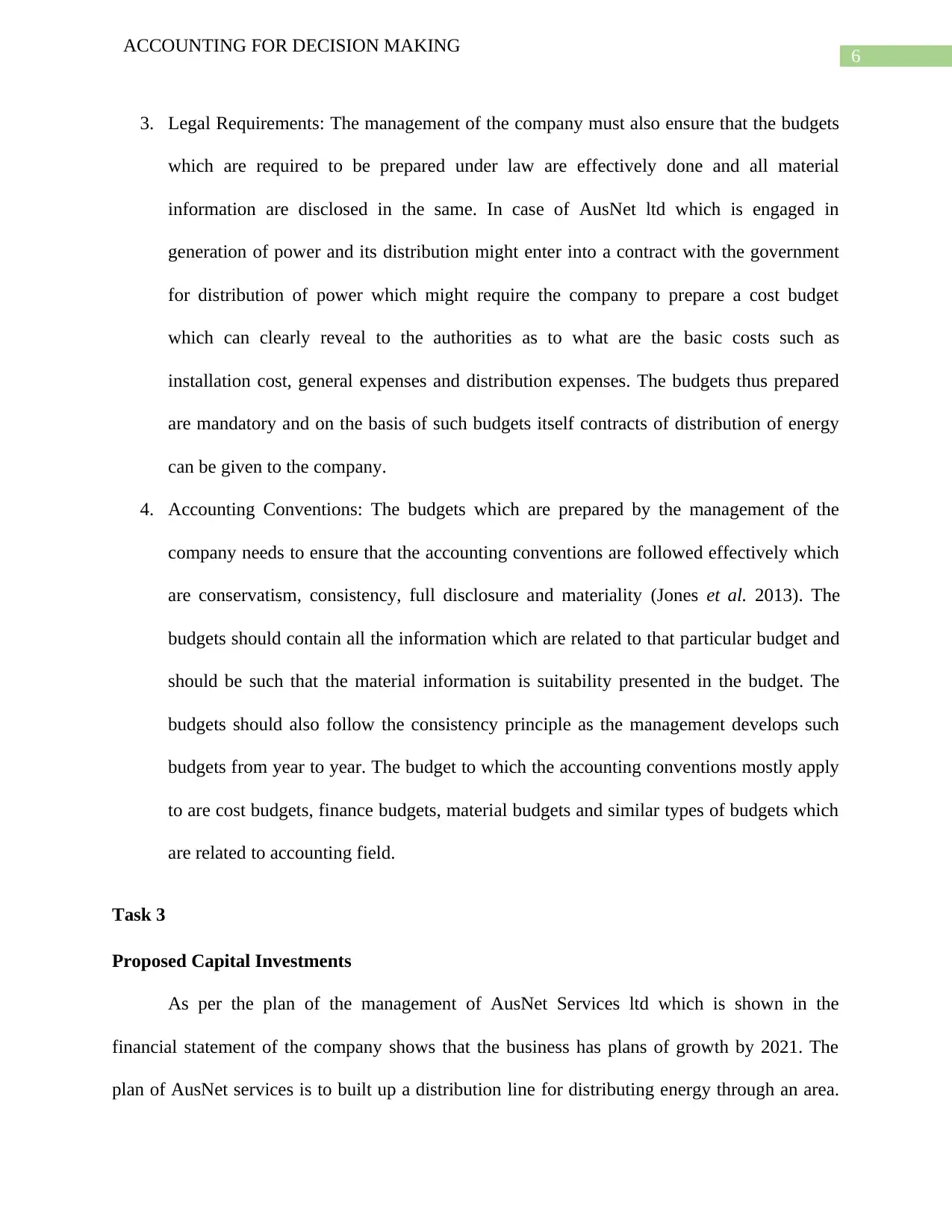
6
ACCOUNTING FOR DECISION MAKING
3. Legal Requirements: The management of the company must also ensure that the budgets
which are required to be prepared under law are effectively done and all material
information are disclosed in the same. In case of AusNet ltd which is engaged in
generation of power and its distribution might enter into a contract with the government
for distribution of power which might require the company to prepare a cost budget
which can clearly reveal to the authorities as to what are the basic costs such as
installation cost, general expenses and distribution expenses. The budgets thus prepared
are mandatory and on the basis of such budgets itself contracts of distribution of energy
can be given to the company.
4. Accounting Conventions: The budgets which are prepared by the management of the
company needs to ensure that the accounting conventions are followed effectively which
are conservatism, consistency, full disclosure and materiality (Jones et al. 2013). The
budgets should contain all the information which are related to that particular budget and
should be such that the material information is suitability presented in the budget. The
budgets should also follow the consistency principle as the management develops such
budgets from year to year. The budget to which the accounting conventions mostly apply
to are cost budgets, finance budgets, material budgets and similar types of budgets which
are related to accounting field.
Task 3
Proposed Capital Investments
As per the plan of the management of AusNet Services ltd which is shown in the
financial statement of the company shows that the business has plans of growth by 2021. The
plan of AusNet services is to built up a distribution line for distributing energy through an area.
ACCOUNTING FOR DECISION MAKING
3. Legal Requirements: The management of the company must also ensure that the budgets
which are required to be prepared under law are effectively done and all material
information are disclosed in the same. In case of AusNet ltd which is engaged in
generation of power and its distribution might enter into a contract with the government
for distribution of power which might require the company to prepare a cost budget
which can clearly reveal to the authorities as to what are the basic costs such as
installation cost, general expenses and distribution expenses. The budgets thus prepared
are mandatory and on the basis of such budgets itself contracts of distribution of energy
can be given to the company.
4. Accounting Conventions: The budgets which are prepared by the management of the
company needs to ensure that the accounting conventions are followed effectively which
are conservatism, consistency, full disclosure and materiality (Jones et al. 2013). The
budgets should contain all the information which are related to that particular budget and
should be such that the material information is suitability presented in the budget. The
budgets should also follow the consistency principle as the management develops such
budgets from year to year. The budget to which the accounting conventions mostly apply
to are cost budgets, finance budgets, material budgets and similar types of budgets which
are related to accounting field.
Task 3
Proposed Capital Investments
As per the plan of the management of AusNet Services ltd which is shown in the
financial statement of the company shows that the business has plans of growth by 2021. The
plan of AusNet services is to built up a distribution line for distributing energy through an area.
Paraphrase This Document
Need a fresh take? Get an instant paraphrase of this document with our AI Paraphraser
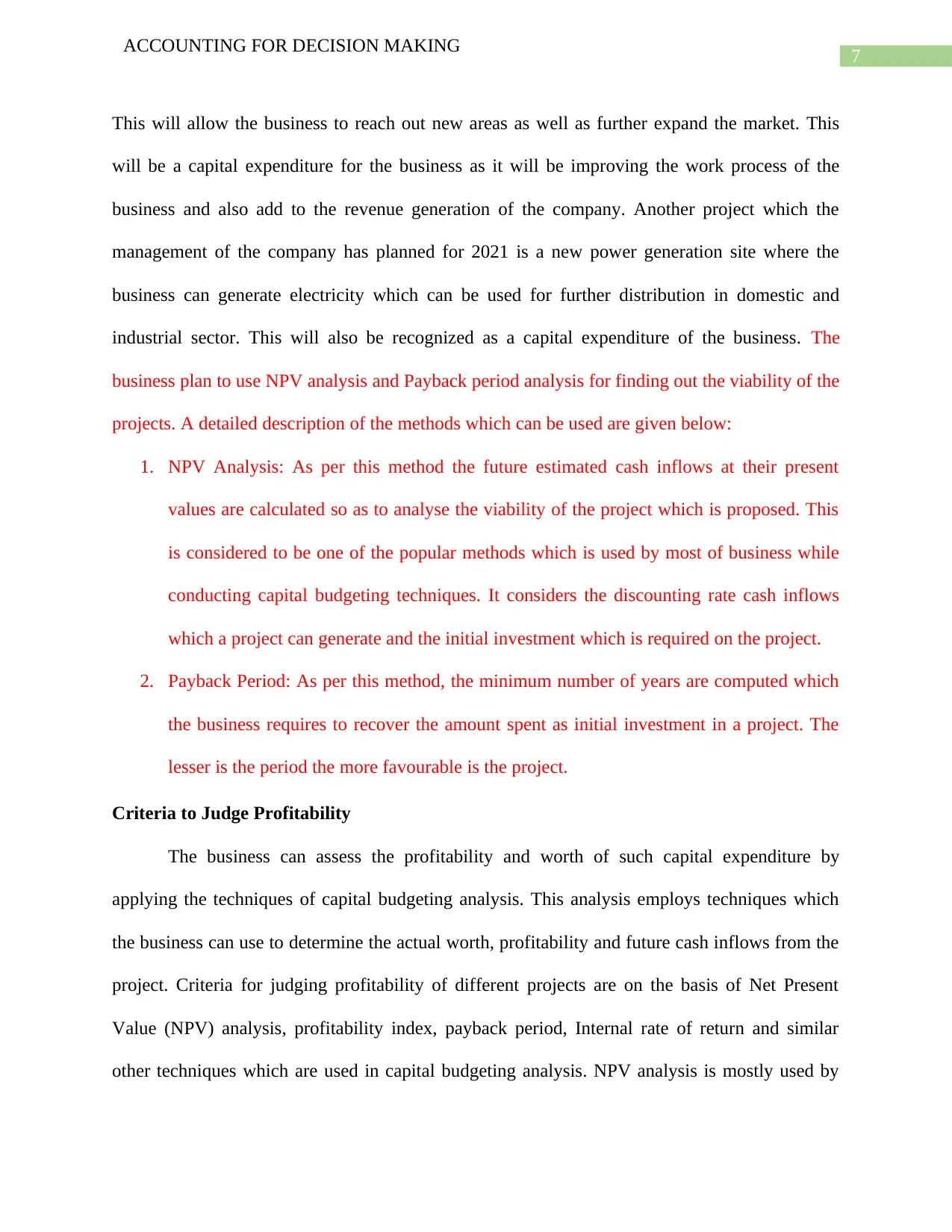
7
ACCOUNTING FOR DECISION MAKING
This will allow the business to reach out new areas as well as further expand the market. This
will be a capital expenditure for the business as it will be improving the work process of the
business and also add to the revenue generation of the company. Another project which the
management of the company has planned for 2021 is a new power generation site where the
business can generate electricity which can be used for further distribution in domestic and
industrial sector. This will also be recognized as a capital expenditure of the business. The
business plan to use NPV analysis and Payback period analysis for finding out the viability of the
projects. A detailed description of the methods which can be used are given below:
1. NPV Analysis: As per this method the future estimated cash inflows at their present
values are calculated so as to analyse the viability of the project which is proposed. This
is considered to be one of the popular methods which is used by most of business while
conducting capital budgeting techniques. It considers the discounting rate cash inflows
which a project can generate and the initial investment which is required on the project.
2. Payback Period: As per this method, the minimum number of years are computed which
the business requires to recover the amount spent as initial investment in a project. The
lesser is the period the more favourable is the project.
Criteria to Judge Profitability
The business can assess the profitability and worth of such capital expenditure by
applying the techniques of capital budgeting analysis. This analysis employs techniques which
the business can use to determine the actual worth, profitability and future cash inflows from the
project. Criteria for judging profitability of different projects are on the basis of Net Present
Value (NPV) analysis, profitability index, payback period, Internal rate of return and similar
other techniques which are used in capital budgeting analysis. NPV analysis is mostly used by
ACCOUNTING FOR DECISION MAKING
This will allow the business to reach out new areas as well as further expand the market. This
will be a capital expenditure for the business as it will be improving the work process of the
business and also add to the revenue generation of the company. Another project which the
management of the company has planned for 2021 is a new power generation site where the
business can generate electricity which can be used for further distribution in domestic and
industrial sector. This will also be recognized as a capital expenditure of the business. The
business plan to use NPV analysis and Payback period analysis for finding out the viability of the
projects. A detailed description of the methods which can be used are given below:
1. NPV Analysis: As per this method the future estimated cash inflows at their present
values are calculated so as to analyse the viability of the project which is proposed. This
is considered to be one of the popular methods which is used by most of business while
conducting capital budgeting techniques. It considers the discounting rate cash inflows
which a project can generate and the initial investment which is required on the project.
2. Payback Period: As per this method, the minimum number of years are computed which
the business requires to recover the amount spent as initial investment in a project. The
lesser is the period the more favourable is the project.
Criteria to Judge Profitability
The business can assess the profitability and worth of such capital expenditure by
applying the techniques of capital budgeting analysis. This analysis employs techniques which
the business can use to determine the actual worth, profitability and future cash inflows from the
project. Criteria for judging profitability of different projects are on the basis of Net Present
Value (NPV) analysis, profitability index, payback period, Internal rate of return and similar
other techniques which are used in capital budgeting analysis. NPV analysis is mostly used by
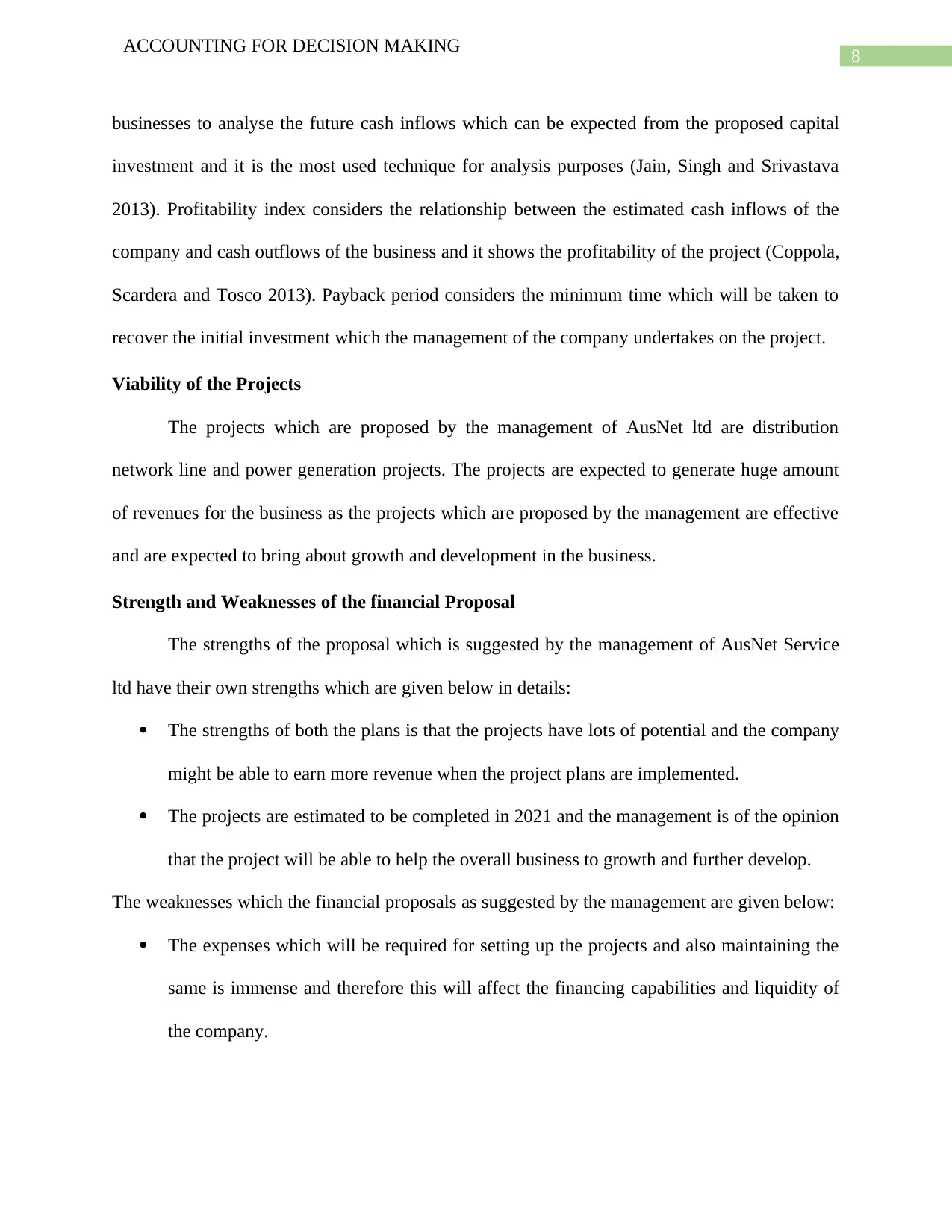
8
ACCOUNTING FOR DECISION MAKING
businesses to analyse the future cash inflows which can be expected from the proposed capital
investment and it is the most used technique for analysis purposes (Jain, Singh and Srivastava
2013). Profitability index considers the relationship between the estimated cash inflows of the
company and cash outflows of the business and it shows the profitability of the project (Coppola,
Scardera and Tosco 2013). Payback period considers the minimum time which will be taken to
recover the initial investment which the management of the company undertakes on the project.
Viability of the Projects
The projects which are proposed by the management of AusNet ltd are distribution
network line and power generation projects. The projects are expected to generate huge amount
of revenues for the business as the projects which are proposed by the management are effective
and are expected to bring about growth and development in the business.
Strength and Weaknesses of the financial Proposal
The strengths of the proposal which is suggested by the management of AusNet Service
ltd have their own strengths which are given below in details:
The strengths of both the plans is that the projects have lots of potential and the company
might be able to earn more revenue when the project plans are implemented.
The projects are estimated to be completed in 2021 and the management is of the opinion
that the project will be able to help the overall business to growth and further develop.
The weaknesses which the financial proposals as suggested by the management are given below:
The expenses which will be required for setting up the projects and also maintaining the
same is immense and therefore this will affect the financing capabilities and liquidity of
the company.
ACCOUNTING FOR DECISION MAKING
businesses to analyse the future cash inflows which can be expected from the proposed capital
investment and it is the most used technique for analysis purposes (Jain, Singh and Srivastava
2013). Profitability index considers the relationship between the estimated cash inflows of the
company and cash outflows of the business and it shows the profitability of the project (Coppola,
Scardera and Tosco 2013). Payback period considers the minimum time which will be taken to
recover the initial investment which the management of the company undertakes on the project.
Viability of the Projects
The projects which are proposed by the management of AusNet ltd are distribution
network line and power generation projects. The projects are expected to generate huge amount
of revenues for the business as the projects which are proposed by the management are effective
and are expected to bring about growth and development in the business.
Strength and Weaknesses of the financial Proposal
The strengths of the proposal which is suggested by the management of AusNet Service
ltd have their own strengths which are given below in details:
The strengths of both the plans is that the projects have lots of potential and the company
might be able to earn more revenue when the project plans are implemented.
The projects are estimated to be completed in 2021 and the management is of the opinion
that the project will be able to help the overall business to growth and further develop.
The weaknesses which the financial proposals as suggested by the management are given below:
The expenses which will be required for setting up the projects and also maintaining the
same is immense and therefore this will affect the financing capabilities and liquidity of
the company.
⊘ This is a preview!⊘
Do you want full access?
Subscribe today to unlock all pages.

Trusted by 1+ million students worldwide
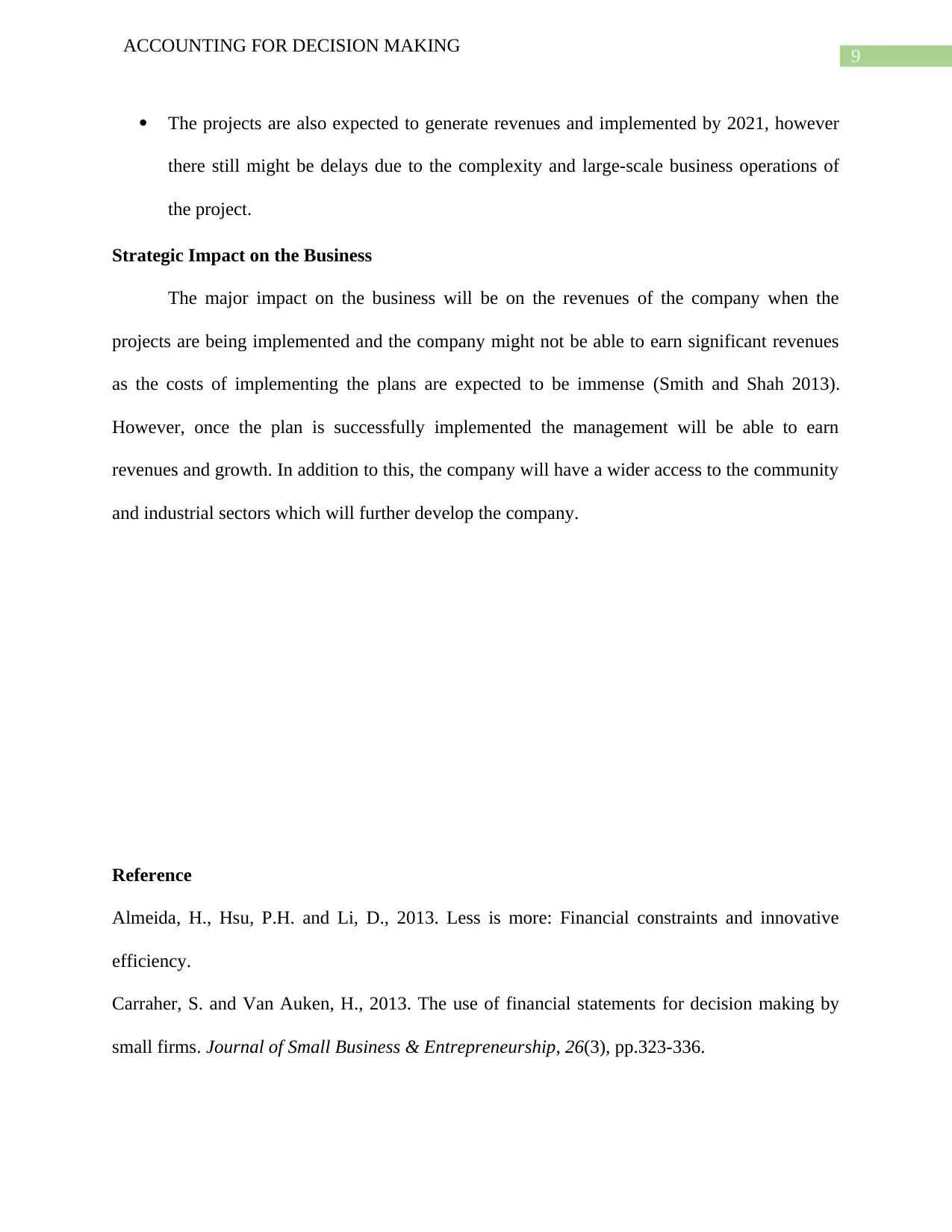
9
ACCOUNTING FOR DECISION MAKING
The projects are also expected to generate revenues and implemented by 2021, however
there still might be delays due to the complexity and large-scale business operations of
the project.
Strategic Impact on the Business
The major impact on the business will be on the revenues of the company when the
projects are being implemented and the company might not be able to earn significant revenues
as the costs of implementing the plans are expected to be immense (Smith and Shah 2013).
However, once the plan is successfully implemented the management will be able to earn
revenues and growth. In addition to this, the company will have a wider access to the community
and industrial sectors which will further develop the company.
Reference
Almeida, H., Hsu, P.H. and Li, D., 2013. Less is more: Financial constraints and innovative
efficiency.
Carraher, S. and Van Auken, H., 2013. The use of financial statements for decision making by
small firms. Journal of Small Business & Entrepreneurship, 26(3), pp.323-336.
ACCOUNTING FOR DECISION MAKING
The projects are also expected to generate revenues and implemented by 2021, however
there still might be delays due to the complexity and large-scale business operations of
the project.
Strategic Impact on the Business
The major impact on the business will be on the revenues of the company when the
projects are being implemented and the company might not be able to earn significant revenues
as the costs of implementing the plans are expected to be immense (Smith and Shah 2013).
However, once the plan is successfully implemented the management will be able to earn
revenues and growth. In addition to this, the company will have a wider access to the community
and industrial sectors which will further develop the company.
Reference
Almeida, H., Hsu, P.H. and Li, D., 2013. Less is more: Financial constraints and innovative
efficiency.
Carraher, S. and Van Auken, H., 2013. The use of financial statements for decision making by
small firms. Journal of Small Business & Entrepreneurship, 26(3), pp.323-336.
Paraphrase This Document
Need a fresh take? Get an instant paraphrase of this document with our AI Paraphraser

10
ACCOUNTING FOR DECISION MAKING
Coppola, A., Scardera, A. and Tosco, D., 2013. Economic profitability and long-term viability in
Italian agriculture. pagri/iap, p.71.
Hope, J. and Fraser, R., 2013. the Budget. Budgetierung im Umbruch?, 1, p.71.
Jain, N., Singh, S.N. and Srivastava, S.C., 2013. A generalized approach for DG planning and
viability analysis under market scenario. IEEE Transactions on Industrial Electronics, 60(11),
pp.5075-5085.
Jones, R., Lande, E., Lüder, K. and Portal, M., 2013. A comparison of budgeting and accounting
reforms in the national governments of France, Germany, the UK and the US. Financial
Accountability & Management, 29(4), pp.419-441.
Katchova, A.L. and Enlow, S.J., 2013. Financial performance of publicly-traded
agribusinesses. Agricultural Finance Review, 73(1), pp.58-73.
Khagram, S., Fung, A. and De Renzio, P. eds., 2013. Open budgets: The political economy of
transparency, participation, and accountability. Brookings Institution Press.
Luechinger, S. and Schaltegger, C.A., 2013. Fiscal rules, budget deficits and budget
projections. International Tax and Public Finance, 20(5), pp.785-807.
Minnis, M. and Sutherland, A., 2017. Financial statements as monitoring mechanisms: Evidence
from small commercial loans. Journal of Accounting Research, 55(1), pp.197-233.
Rensburg, R. and Botha, E., 2014. Is Integrated Reporting the silver bullet of financial
communication? A stakeholder perspective from South Africa. Public Relations Review, 40(2),
pp.144-152.
Smith, S.W. and Shah, S.K., 2013. Do innovative users generate more useful insights? An
analysis of corporate venture capital investments in the medical device industry. Strategic
entrepreneurship journal, 7(2), pp.151-167.
ACCOUNTING FOR DECISION MAKING
Coppola, A., Scardera, A. and Tosco, D., 2013. Economic profitability and long-term viability in
Italian agriculture. pagri/iap, p.71.
Hope, J. and Fraser, R., 2013. the Budget. Budgetierung im Umbruch?, 1, p.71.
Jain, N., Singh, S.N. and Srivastava, S.C., 2013. A generalized approach for DG planning and
viability analysis under market scenario. IEEE Transactions on Industrial Electronics, 60(11),
pp.5075-5085.
Jones, R., Lande, E., Lüder, K. and Portal, M., 2013. A comparison of budgeting and accounting
reforms in the national governments of France, Germany, the UK and the US. Financial
Accountability & Management, 29(4), pp.419-441.
Katchova, A.L. and Enlow, S.J., 2013. Financial performance of publicly-traded
agribusinesses. Agricultural Finance Review, 73(1), pp.58-73.
Khagram, S., Fung, A. and De Renzio, P. eds., 2013. Open budgets: The political economy of
transparency, participation, and accountability. Brookings Institution Press.
Luechinger, S. and Schaltegger, C.A., 2013. Fiscal rules, budget deficits and budget
projections. International Tax and Public Finance, 20(5), pp.785-807.
Minnis, M. and Sutherland, A., 2017. Financial statements as monitoring mechanisms: Evidence
from small commercial loans. Journal of Accounting Research, 55(1), pp.197-233.
Rensburg, R. and Botha, E., 2014. Is Integrated Reporting the silver bullet of financial
communication? A stakeholder perspective from South Africa. Public Relations Review, 40(2),
pp.144-152.
Smith, S.W. and Shah, S.K., 2013. Do innovative users generate more useful insights? An
analysis of corporate venture capital investments in the medical device industry. Strategic
entrepreneurship journal, 7(2), pp.151-167.

11
ACCOUNTING FOR DECISION MAKING
ACCOUNTING FOR DECISION MAKING
⊘ This is a preview!⊘
Do you want full access?
Subscribe today to unlock all pages.

Trusted by 1+ million students worldwide
1 out of 12
Related Documents
Your All-in-One AI-Powered Toolkit for Academic Success.
+13062052269
info@desklib.com
Available 24*7 on WhatsApp / Email
![[object Object]](/_next/static/media/star-bottom.7253800d.svg)
Unlock your academic potential
Copyright © 2020–2025 A2Z Services. All Rights Reserved. Developed and managed by ZUCOL.





